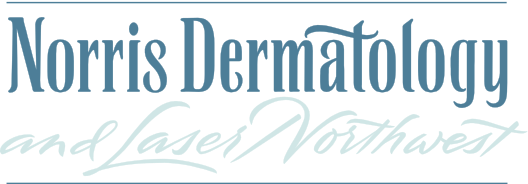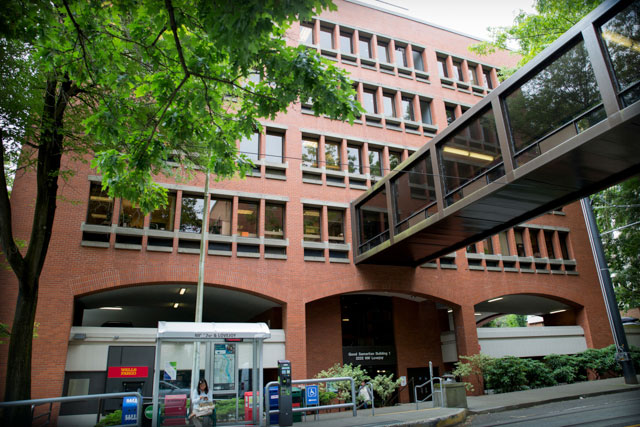Portland Rosacea Treatments

Rosacea is a common skin condition in Portland that is a type of adult acne, and Dr. Norris of Norris Dermatology & Laser Northwest Portland OR provides rosacea treatments and skin care routines to clear up rosacea. Patients with rosacea have easy flushing, persistent redness or erythema of the skin along with broken blood vessels and acne bumps on the face. Up to 20% of patients with rosacea may also have dry gritty eyes, which may be a type of ocular rosacea. Ocular rosacea is a condition that should not go untreated.
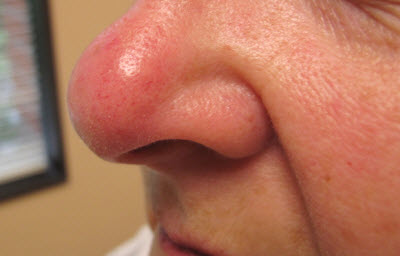 Many external factors trigger rosacea such as sun exposure, exercise, medications, red wine, hot drinks (e.g. coffee, tea), and spicy foods. Avoidance of these triggers may help minimize the flaring of rosacea. This is not that easy to do at times. The flaring of rosacea is seen as redness on the skin that may last all day or it may come and go. In addition to the redness, acne lesions develop in the areas of redness. Fortunately, Rosacea does not always progress. Some individuals have a mild case and others have a more severe case.
Many external factors trigger rosacea such as sun exposure, exercise, medications, red wine, hot drinks (e.g. coffee, tea), and spicy foods. Avoidance of these triggers may help minimize the flaring of rosacea. This is not that easy to do at times. The flaring of rosacea is seen as redness on the skin that may last all day or it may come and go. In addition to the redness, acne lesions develop in the areas of redness. Fortunately, Rosacea does not always progress. Some individuals have a mild case and others have a more severe case.
Most patients with rosacea have sensitive skin. Many skin care products including lotions and creams and moisturizers irritate the skin in patients with rosacea. Even if a product says it is oil-free it may irritate the skin and even cause it to flare with more acne lesions or bumps.
A Simple Skin Care Routine is Essential in Managing Rosacea
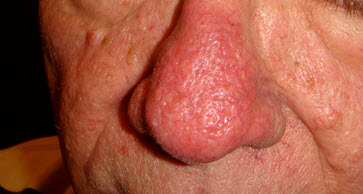 The first step in treating rosacea is to avoid triggers that cause flushing. We understand this is not always easy to do. For example, exercise may flare rosacea but we don’t want patients to stop exercising. It may be helpful to find a cool space with a fan if you are exercising indoors. Some types of alcohol will flare rosacea more than others. Red wine appears to be a bigger trigger than white wine. The sun is also a common trigger for many patients with rosacea but so are sunscreen lotions. Protecting with hats and using shade as a sun protectant will be one alternative to minimize flushing when outdoors. For women using mineral powder as a sunscreen may minimize the irritation that many sunscreen creams have on the facial skin. Alcohol based sunscreens may be more tolerable for sun protection. You spray the sunscreen onto your hand and pat it onto your face. Be sure to avoid breathing in the spray.
The first step in treating rosacea is to avoid triggers that cause flushing. We understand this is not always easy to do. For example, exercise may flare rosacea but we don’t want patients to stop exercising. It may be helpful to find a cool space with a fan if you are exercising indoors. Some types of alcohol will flare rosacea more than others. Red wine appears to be a bigger trigger than white wine. The sun is also a common trigger for many patients with rosacea but so are sunscreen lotions. Protecting with hats and using shade as a sun protectant will be one alternative to minimize flushing when outdoors. For women using mineral powder as a sunscreen may minimize the irritation that many sunscreen creams have on the facial skin. Alcohol based sunscreens may be more tolerable for sun protection. You spray the sunscreen onto your hand and pat it onto your face. Be sure to avoid breathing in the spray.
Diet does play a role in rosacea. It is well known that spicy foods will cause an increase in flushing in some patients with rosacea. In addition hot and foods and drinks may also cause flushing.
The second step is to avoid scrubs, astringents, toners, and cosmetics requiring solvents to be removed. Even facials may worsen Rosacea. A very simple skin care routine is recommended. In the case of rosacea, LESS IS BETTER.
Soaps for Treating Rosacea
Cetaphil Cleanser, Sodium Sulfacetamide, CeraVe Wash.
Sunscreens for Treating Rosacea
Alcohol based sunscreens, Mineral based powder, SPF 15/20/30, example Bare Minerals, though any mineral based powder will work.
Skin Moisturizers for Treating Rosacea
Rosewater in Glycerin, which is an old fashioned simple moisturizer that soothes dry skin. Rosacea medications may cause scaling and/or irritation of the skin. As the acne like breakout heals, a little scale develops around the lesion. This scale may be mistaken for dry skin, which it is not. The scale is the sign the rosacea is healing. Moisturizers may actually cause more irritation.
Note: Moisturizers have one main function and that is to plump the skin temporarily. Moisturizers DO NOT prevent wrinkles. Wrinkles and premature aging is prevented by sun protection and sunscreen.
Cosmetics for Treating Rosacea
Use mineral-based powder for liquid foundation and cover-up sticks. Even oil-free foundation can irritate the skin and promote acne outbreaks.
Rosacea Skin Care Routine
- Simple pH balanced wash
- Spritz with Rosewater in Glycerin
- Apply topical Rosacea medication if indicated at night
- Apply sunscreen powder before going out in the morning.
Cleanse with a mild pH balanced cleanser like Cetaphil Normal to Oily Skin Cleanser. Moisturizers may aggravate rosacea, so Rosewater in Glycerin is a great alternative to soothing the dryness that occurs after washing the face. When you wash your face you wash off the oils. It will take your skin about 30 minutes to recover from this and new oil formation will occur. For women, using mineral powder will provide very good sun protection without aggravation of the rosacea. Using alcohol-based sunscreens may also be a good option for sun protection.
A number of prescription oral and topical preparations are used to treat rosacea. The medications will treat the acne like outbreaks. The active ingredients in the topical medications might include azelaic acid, sodium sulfacetamide, or an antibiotic called metronidazole. These medications work to suppress the inflammation associated with rosacea. Oral doxycycline and minocycline can also be used. The low dose (a dose of less than 40mg at a time) of doxycycline is used to suppress the inflammation associated with Rosacea without killing normal good bacteria.
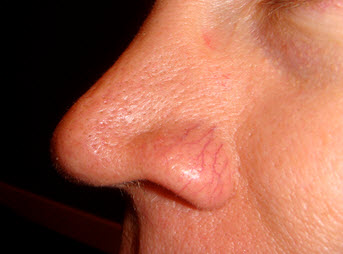 Laser therapies are also available in Portland to treat the redness and broken blood vessels that cause the redness associated with rosacea. Neither the oral or topical medications used to treat rosacea will not treat the broken blood vessels. We know that flushing triggers the flaring of rosacea. The V-Beam laser is the gold standard used to remove blood vessels that cause flushing in rosacea. With these vessels removed, there is less flushing and less flaring of rosacea! The flaring that decreases includes both the overall redness of the face and the acne outbreaks. Over the years many men and woman have been able to control their rosacea with laser treatments alone. V-Beam Laser Treatment helps with the redness associated with Rosacea.
Laser therapies are also available in Portland to treat the redness and broken blood vessels that cause the redness associated with rosacea. Neither the oral or topical medications used to treat rosacea will not treat the broken blood vessels. We know that flushing triggers the flaring of rosacea. The V-Beam laser is the gold standard used to remove blood vessels that cause flushing in rosacea. With these vessels removed, there is less flushing and less flaring of rosacea! The flaring that decreases includes both the overall redness of the face and the acne outbreaks. Over the years many men and woman have been able to control their rosacea with laser treatments alone. V-Beam Laser Treatment helps with the redness associated with Rosacea.
Treatment for Rosacea
Oral Antibiotics & Topical Creams/Lotions
Oral Antibiotic: Tetracycline, Doxycycline, and Minocycline
The Tetracycline antibiotics are used for their ant-inflammatory properties in the treatment of Rosacea. They are all effective. Tetracycline is presently unavailable due to a shortage worldwide. Doxycycline and Minocycline are 2nd and 3rd generation medications. They are both effective. There is now a shortage of Doxycycline but the drug is still available.
Doxycycline and Minocycline SHOULD be taken with food. Often times the pharmacist puts a label on the bottle stating the medication should be taken on an empty stomach. However, the drug is better absorbed with food, so it will actually be more effective if taken with food in the stomach. HOWEVER, doxycycline should NOT be taken with calcium or any DAIRY products. You need to wait one hour to have calcium or dairy. If the two are taken together the drug is ineffective.
Low Dose Doxycycline:
One of the safest oral treatments for Rosacea is called sub-microbial Doxycycline. Sub-microbial dosing means that the dose is lower than that which would kill bacteria, especially our normal flora. The tetracycline antibiotics are NOT used as antibiotics to treat rosacea or acne. They are used for their excellent anti-inflammatory properties, suppressing the red tender and irritated bumps associated with Rosacea. For the dose to be low or “anti-inflammatory” the dose needs to be under 40mg at a time. The FDA dosing is 20mg every 12 hours. A 40mg time released form of Doxycycline is available.
The benefit of the low dose of doxycycline is that the normal flora is not affected and thus no issues with bacterial resistance. In addition, up to 20% of patients with rosacea have involvement of the eyes. This is called ocular rosacea. Doxycycline would be the gold standard for treating these symptoms.
We have patients cut a 100mg tablet into ¼’s — and take ¼ in the morning and ¼ in the evening. The pills should be taken with food – but avoid dairy products for an hour after taking the drug. The major risks with Doxycycline are sun sensitivity and a possible medication allergic reaction Doxycycline has been reported in some cases to cause irritation of the esophagus, which can be minimized by taking doxycycline with fluids atleast one hour before lying down.
In the last few months a shortage of Doxycycline has occurred and as a result the price of this drug went up 10 fold. Minocycline is very good at treating rosacea but there are more side effects associated with it than Doxycycline including: bone marrow suppression, drug induced lupus, DRESS syndrome, hyperpigmentation of the cartilage, gums, skin as well as pseudo tumor ceribri.
Topical creams:
There are topical medications used to treat the inflammatory component, pustules and red papules (acne like lesions). Three medication groups:
- Sodium Sulfacetamide/sulfur
- Azaelic Acid
- Metronidazole
All three of these topical products work by decreasing inflammation and the acne like lesions. Neither the topical or oral medications treat the blood vessels that dilate up from the frequent flushing associated with rosacea.
If you are allergic to Sulfa you should avoid sodium sulfacetamide/sulfur. Azaelic acid is a topical cream or lotion with anti-inflammatory effects. It may also help with hyperpigmentation that may develop from previous inflammatory lesions and even sun damage.
Metronidazole is a topical antibiotic that is very helpful in rosacea that has a pustular component and even sometimes an overgrowth of Staphylococcus aureus bacteria.
You can learn more about rosacea treatments at American Academy of Dermatology.
